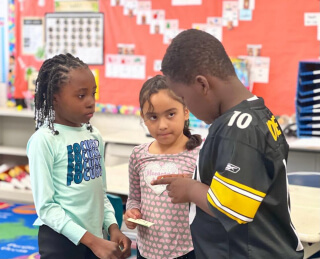
How to Increase Student Engagement in Pair Sharing Using Scaffolding
Step 1: Reduce Student Anxiety by Assigning Partners
Unsafe Approach: “Find a Partner.”
Safe Approach: Assign Partners Strategically
Bonus Tip: Rotate partners regularly to increase peer interaction and expose students to diverse perspectives.
Step 2: Model the Conversation to Scaffold Learning
Unsafe Approach: “Talk About It.”
Safe Approach: Use Teacher Modeling
- A sample discussion between you and another student.
- A student-to-student model while the class observes.
- A guided dialogue framework with sentence starters written on the board.
Bonus Tip: Display sentence starters like:
- "One thing I noticed is…"
- "I agree/disagree because…"
- "Something that stood out to me was…"
Step 3: Provide Sentence Starters to Encourage Student Talk
Unsafe Approach: "Just ask your partner what they think."
Safe Approach: Use Sentence Starters for Academic Conversations
- For opinion-based discussions: “I think ___ because ___.”
- For analyzing texts: “One theme I noticed is ___.”
- For problem-solving: “A possible solution could be ___.”
Bonus Tip: Encourage students to expand on responses using academic conversation techniques like asking, "Can you say more about that?"
Step 4: Assign Turn-Taking Roles to Reduce Awkwardness
Unsafe Approach: "Just take turns talking."
Safe Approach: Use Turn-Taking Cues
- “Speaker & Listener” – One student speaks, the other summarizes.
- “Questioner & Responder” – One asks a question, the other answers.
- Fun pairs like “Peanut Butter & Jelly” – Peanut Butter goes first, then Jelly.
Bonus Tip: Rotate roles each round to develop verbal participation skills.
Step 5: Set Clear Expectations for What to Share
Unsafe Approach: “Just share something.”
Safe Approach: Give Specific Discussion Prompts
- "Each person must share two observations before responding."
- "Use the 30-second sand timer to keep answers balanced."
- "Summarize your partner’s idea before adding your own."
Bonus Tip: Timed student talk strategies help keep discussions focused.
Step 6: Adjust Physical Positioning to Improve Engagement
Unsafe Approach: "Talk to your partner" (while still facing the front).
Safe Approach: Rearrange Seating for Active Learning
- Have students stand and face each other.
- Allow movement to designated discussion zones.
- Encourage eye contact and active listening.
Bonus Tip: Structured classroom engagement leads to higher participation and confidence in students.
Step 7: Use Movement to Energize Peer Discussions
Unsafe Approach: "Just discuss at your desk."
Safe Approach: Incorporate Movement into Pair Sharing
- Have students switch discussion partners after a few minutes.
- Use “Find Someone Who…” activities to encourage movement.
- Assign discussion stations around the classroom.
Bonus Tip: Movement reduces speech anxiety and helps students feel more comfortable sharing ideas.
Final Thoughts: The Power of Scaffolding Student Talk
By scaffolding pair sharing, you transform the classroom into a safe space for verbal participation.
Key Takeaways
- Reduce anxiety by assigning partners.
- Model discussions before students engage.
- Use sentence starters to build confidence.
- Assign turn-taking roles to structure discussions.
- Set clear expectations to enhance focus.
- Adjust seating to create natural conversations.
- Encourage movement to energize learning.
FAQ: Scaffolding Student Engagement in Pair Sharing
Q: How do I help shy students participate in classroom discussions?
- Use sentence starters to guide responses.
- Assign partners to reduce social pressure.
- Encourage peer interaction in low-stress settings.
Q: What are the best strategies to encourage student talk?
- Model structured conversations before students practice.
- Provide turn-taking cues for clarity.
- Use active learning techniques to boost engagement.
Q: How can I make classroom discussions more effective?
- Set clear expectations for student responses.
- Create movement-based activities to keep students engaged.
- Rotate partners to increase student discourse.
Want More Strategies?
Visit TESOL Trainers for expert-led teacher training workshops: www.tesoltrainers.com
Join our newsletter for more classroom engagement techniques!
Sign up for our live, remote PD series - The English Learner Institute to master scaffolding, SIOP®, and much more!

